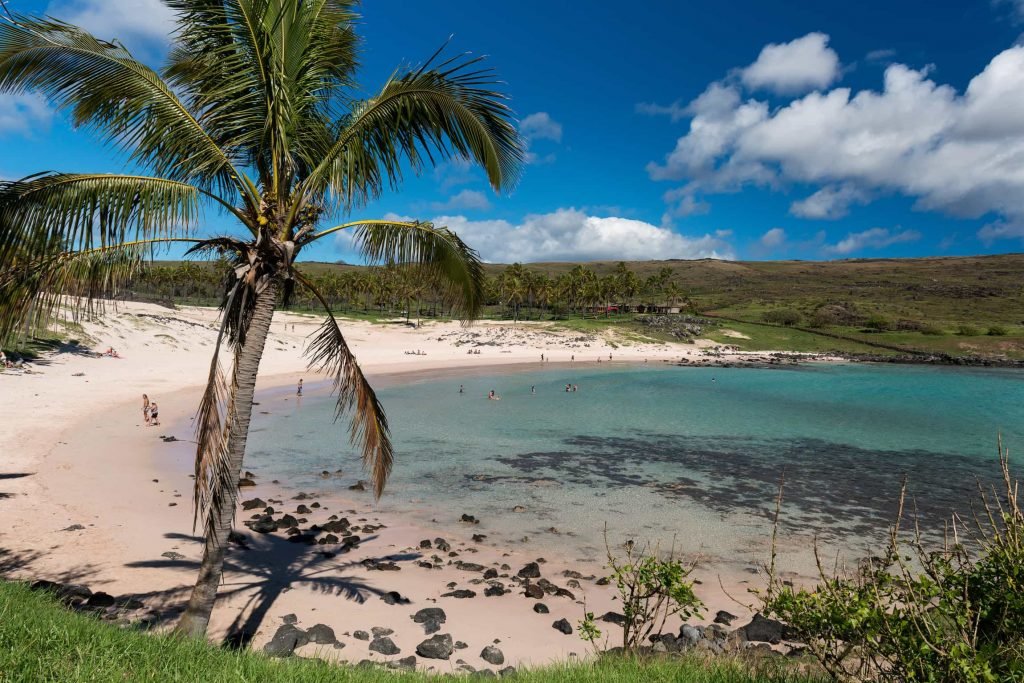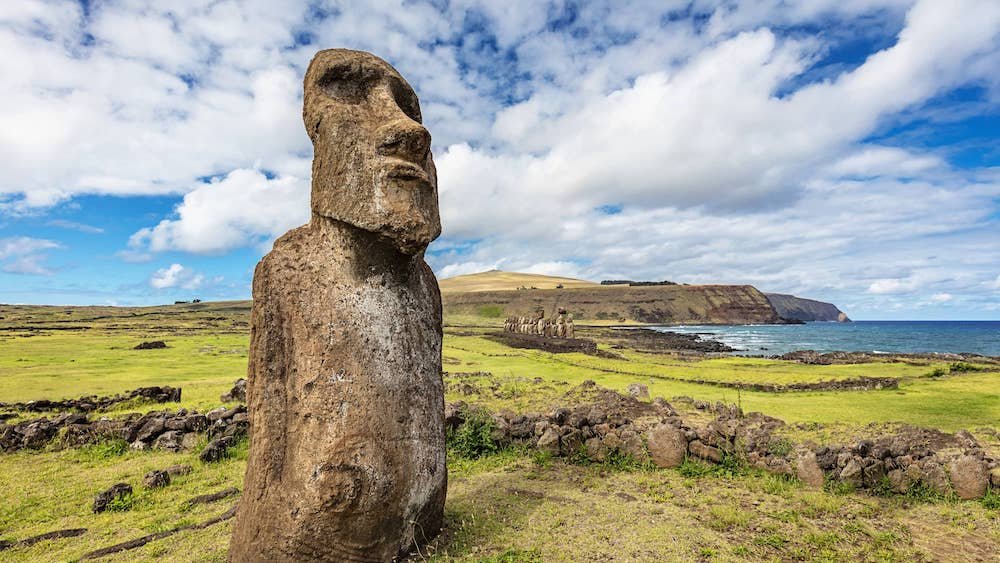
Want to discover how to get to Easter Island and prepare yourself for a holiday?
Nestled in the vast expanse of the Pacific Ocean, Easter Island, or Rapa Nui, as it is known to its indigenous people, stands as a beacon of ancient civilization and enigmatic allure.
This remote Chilean territory, marked by its iconic Moai statues—monolithic human figures carved by the Rapa Nui people centuries ago—captures the imagination of travelers worldwide.
The island’s unique blend of breathtaking landscapes, rich cultural heritage, and mysterious historical sites makes it a must-visit destination for those seeking an experience far beyond the ordinary.
Understanding how to get to Easter Island is crucial for anyone planning to immerse themselves in its captivating beauty.
The journey to this isolated island is not a straightforward affair, given its remote location over 2,000 miles from the nearest continent.
This makes the planning and research phase an integral part of the travel process.
Knowing the best routes to take, the most favorable times to visit, and how to navigate the island are essential pieces of information that can make or break your trip.
Given its isolation and the limited means of access, the importance of meticulously planning how to get to Easter Island cannot be overstated.
Whether it’s selecting the right flights, understanding entry requirements, or simply figuring out the logistics of island transport, each step requires careful consideration.
This not only ensures a smoother journey but also helps in making the most of your time on this enigmatic island, allowing you to fully absorb the cultural, historical, and natural beauty that Easter Island has to offer.
Understanding Easter Island
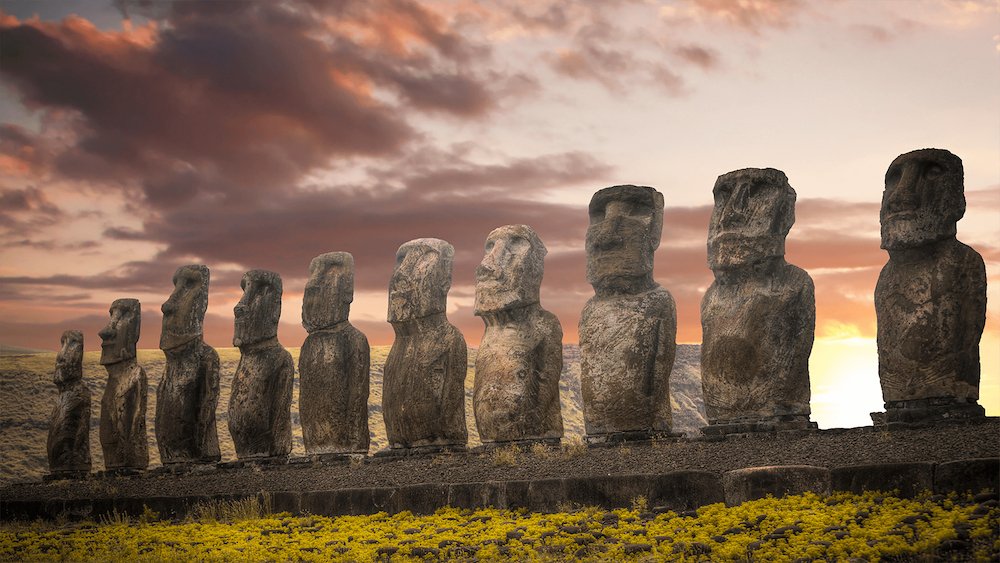
Location and Geographical Significance
Easter Island, known locally as Rapa Nui, is a small volcanic island situated in the southeastern Pacific Ocean.
At approximately 2,300 miles west of Chile and 2,500 miles east of Tahiti, its remote location makes it one of the most isolated inhabited islands on Earth.
This isolation has contributed to the development of a unique ecosystem and a distinctive culture that has fascinated researchers and travelers alike for centuries.
The island spans about 63 square miles, making it relatively small, but its geographical isolation has had a profound impact on its biodiversity and cultural evolution.
Brief History and Cultural Highlights
The history of Easter Island is as captivating as its landscapes, marked by remarkable achievements and mysterious declines.
Believed to have been first settled by Polynesian navigators around 1200 AD, the island’s inhabitants developed a complex society in complete isolation from the rest of the world.
They are best known for their monumental creations: the Moai statues.
These gigantic stone figures, averaging 13 feet in height and weighing 14 tons, were carved from volcanic rock between the 13th and 16th centuries to represent the ancestors of the Rapa Nui people, serving both as religious icons and symbols of political and social power.
The Moai statues are scattered across the island, with many positioned on ceremonial platforms called Ahu.
The purpose and methods used to transport these colossal figures remain subjects of speculation and study, adding to the island’s allure and mystique.
The largest Moai ever erected, known as Paro, stands at about 33 feet tall and weighs approximately 82 tons, exemplifying the extraordinary engineering skills of the ancient Rapa Nui people.
Rapa Nui National Park, a UNESCO World Heritage Site since 1995, encompasses much of the island’s area, protecting its historical landmarks and natural wonders.
Within its boundaries lie not only the famous Moai statues but also other significant archaeological sites, including petroglyphs, ceremonial villages, and ahu.
The park is a testament to the island’s rich cultural legacy and its people’s resilience in the face of environmental and social challenges.
Easter Island’s history is also marked by periods of environmental strain and social upheaval.
Deforestation, soil depletion, and the pressures of a growing population led to social conflict and a decline in the traditional society long before European contact in the 18th century.
Today, the Rapa Nui people continue to inhabit the island, blending traditional practices with modern influences and striving to preserve their heritage amidst the challenges of tourism and external pressures.
Planning Your Trip

Deciding the Best Time to Visit
Overview of Seasonal Weather Patterns
Easter Island experiences a subtropical oceanic climate, characterized by relatively mild weather throughout the year.
The warmest months are January through March, with average temperatures hovering around 73°F (23°C), making it an ideal time for beach activities and island exploration.
The cooler season falls between June and August, where temperatures average around 64°F (18°C), still quite pleasant for outdoor adventures.
Rainfall is spread throughout the year, with the heaviest rains typically occurring in April and May.
However, showers are usually short-lived, clearing up quickly to reveal the island’s natural beauty once again.
Given its oceanic setting, the weather can be unpredictable, so it’s wise to pack for all conditions.
Considerations for Crowd Sizes and Events
The peak tourist season on Easter Island aligns with its warmest months, from January to March.
This period coincides with the Tapati Rapa Nui Festival, a vibrant cultural event showcasing local music, dance, and traditional sports.
While this is a fantastic time to experience the island’s culture, accommodations can be scarce and prices may be higher.
For those seeking a quieter visit, April through June or September through November offers a balance of pleasant weather and fewer tourists.
This off-peak season is perfect for exploring the island at a more relaxed pace.
Budgeting for Your Trip
Approximate Costs for Transportation, Accommodation, Food, and Activities
The cost of getting to and enjoying Easter Island can vary widely based on travel style, the season, and personal preferences.
Flights to Easter Island, being the major expense, can range significantly depending on your departure point and booking time.
Expect to budget around $800 to $1,200 for round-trip flights from Santiago, Chile, the most common gateway to Easter Island.
Accommodations offer something for every budget, from hostels and guesthouses averaging $50-$100 per night to more luxurious hotels that can cost upwards of $250 per night.
Daily expenses for food and drinks can be estimated at around $30-$50 per person, considering both local eateries and more tourist-oriented restaurants.
Activities and tours vary in price, from free self-guided hikes to paid guided tours costing $50-$100, depending on the length and exclusivity of the experience.
Entrance to Rapa Nui National Park, which grants access to the island’s most iconic sites, requires a ticket that costs approximately $80 for non-Chilean visitors, valid for multiple entries over a 10-day period.
Tips for Saving Money and Finding Deals
- Book Flights Early: Airfare to Easter Island can be expensive, but booking several months in advance can secure better deals.
- Stay in Guesthouses or Hostels: These offer a more authentic and cost-effective accommodation option compared to hotels.
- Eat Like a Local: Venture beyond the tourist areas to find eateries favored by locals for more affordable and authentic dining experiences.
- Group Tours: Opting for group tours instead of private ones can significantly cut down on costs.
- Travel Off-Peak: Visiting outside the January to March peak season can lead to savings on both flights and accommodations.
- Leverage Travel Points: If you have them, using airline points or travel rewards can dramatically reduce the cost of flights.
Planning a trip to Easter Island requires careful consideration of both the time of year and how you allocate your budget.
By following these tips and planning ahead, you can ensure a memorable visit to this enchanting island without breaking the bank.
Transportation Options to Easter Island
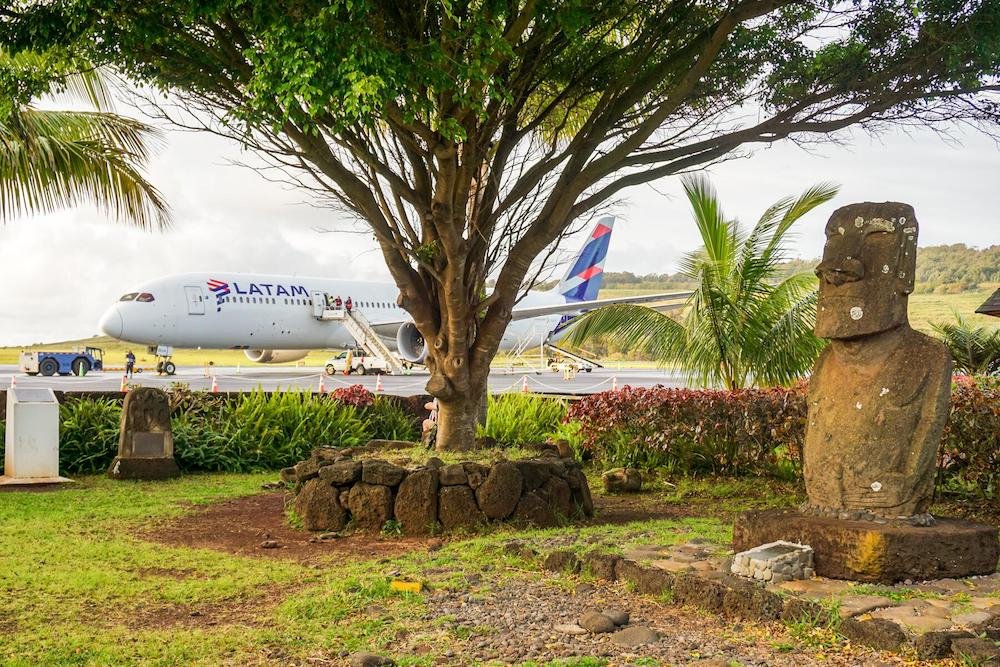
Main Routes to Easter Island
Detailed Explanation of the Primary Airports and Airlines That Serve Easter Island
The lifeline to Easter Island is Mataveri International Airport (IPC), the island’s sole airport, which serves as the main gateway for travelers venturing to this remote destination.
Despite its isolated location, the airport is well-equipped to handle international flights, mainly due to the runway extension initially facilitated to serve as an emergency landing site for space shuttles.
Today, it connects the island with the outside world, primarily through flights operated by LATAM Airlines, the main airline offering regular service to the island.
Overview of Cities Offering Direct Flights to Easter Island
Santiago, Chile (SCL), is the principal hub for direct flights to Easter Island.
The flight from Santiago to Easter Island typically takes about 5 to 6 hours, covering a distance of over 3,700 kilometers across the Pacific Ocean.
Though less frequent, there are also occasional services from other locations, subject to change and seasonal adjustments.
Travelers should check with airlines for the most current routes and schedules.
Booking Flights
Tips on Booking Flights
- Early Reservations: To secure the best rates, book your flight to Easter Island several months in advance, especially if you plan to visit during peak season or during the Tapati Festival.
- Flight Comparison Tools: Utilize online comparison tools and websites to compare flight prices and schedules. This can help you find the most cost-effective options.
- Flexible Dates: If possible, be flexible with your travel dates. Sometimes, adjusting your departure or return by a day or two can lead to significant savings.
- Airline Alerts: Sign up for fare alerts from airlines and travel sites. This way, you’ll be notified of any deals or price drops to Easter Island.
Mention of Any Common Stopovers or Layovers
Most flights to Easter Island from international destinations include a stopover in Santiago, Chile.
Depending on your point of origin, you may also have layovers in other South American cities before connecting in Santiago.
Traveling Within Easter Island
Options for Getting Around the Island
- Car Rentals: Renting a car is a popular option for visitors who value flexibility and wish to explore the island at their own pace. Several rental agencies operate near the airport and in Hanga Roa, the island’s main town.
- Tours: Joining guided tours is an excellent way to learn about the island’s history and culture from knowledgeable guides. Many tours cover significant archaeological sites and provide insights not easily gleaned from guidebooks.
- Public Transportation: While limited, there is a small network of taxis and shuttle services in Hanga Roa that can be used for short distances. There is no formal public bus service on the island.
Recommendations for Eco-Friendly Travel Options
- Bicycle Rentals: For shorter distances, renting a bicycle is a sustainable and healthful way to explore, offering a closer connection to the island’s stunning landscapes.
- Walking Tours: Participating in walking tours not only minimizes environmental impact but also allows for a more intimate exploration of the island’s natural and archaeological sites.
- Support Local: Using local services and joining tours operated by indigenous Rapa Nui people supports the local economy and promotes sustainable tourism practices.
Must-See Attractions and Activities
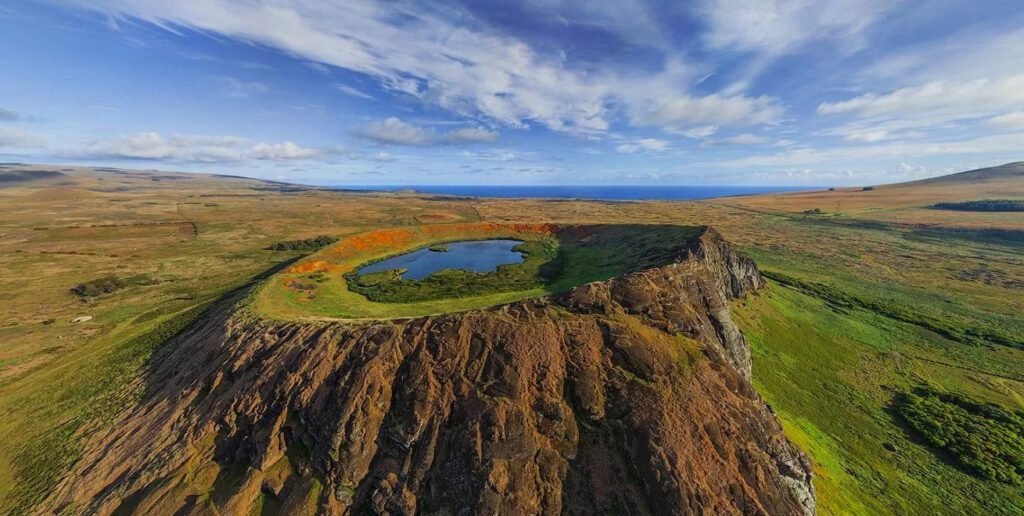
Easter Island, a land of mystery and awe, is home to some of the most captivating ancient sites and natural wonders in the world.
Here are the must-see attractions and recommended activities that promise an unforgettable experience.
Highlighting Key Sites
- Ahu Tongariki: The largest ceremonial platform on the island, Ahu Tongariki, is an iconic symbol of Easter Island. With 15 majestic Moai statues standing in a row against the backdrop of the Pacific Ocean, this site offers a glimpse into the island’s ancient past and is a perfect spot for sunrise viewing.
- Rano Raraku: Often referred to as the nursery of the Moai, Rano Raraku is a volcanic crater that served as a quarry for the island’s stone statues. Here, visitors can see partially carved Moai still attached to the rock, providing insight into how these colossal figures were created. The site’s green slopes and the lake at the crater’s bottom add to its mystical allure.
- Anakena Beach: Anakena, with its white coral sand and swaying palm trees, offers a tropical paradise on this remote island. But it’s not just the beach’s beauty that attracts visitors; Anakena is also an important archaeological site, home to Ahu Nau Nau and Ahu Ature Huki, which boast some of the best-preserved Moai statues on the island.
Recommended Tours and Activities
- Cultural Experiences: To truly understand the spirit of Rapa Nui, engage in cultural experiences such as attending a traditional Polynesian dance performance, visiting the local markets to see the crafts and foods unique to the island, or participating in a Hei (flower crown) workshop.
- Hiking: Easter Island’s dramatic landscapes offer excellent hiking opportunities. Trails lead to various remote corners of the island, including the top of Terevaka, the island’s highest point, offering panoramic views. Hikes can vary in difficulty, from easy walks to more challenging treks, such as the coastal path from Anakena to Hanga Roa.
- Scuba Diving: The crystal-clear waters around Easter Island are perfect for scuba diving. The marine biodiversity, along with underwater Moai statues (a modern addition for divers), make for an extraordinary underwater adventure. Diving excursions cater to all levels, from beginners to experienced divers, and are an excellent way to explore the island’s hidden underwater world.
- Attend the Tapati Festival: If you visit in early February, the Tapati Rapa Nui Festival is a cultural highlight not to be missed. This annual event celebrates Rapa Nui culture through music, dance, and traditional sports competitions, such as the thrilling Haka Pei, where participants slide down a hill on banana trunks.
Conclusion
Embarking on a journey to Easter Island, a land shrouded in history and mystery, offers an unparalleled adventure into the heart of the Pacific.
From the awe-inspiring Moai statues standing sentinel over the landscape to the pristine beaches and rich cultural traditions of the Rapa Nui people, this remote island beckons with the promise of discovery and enlightenment.
As we’ve explored, understanding how to get to Easter Island and making the most of your visit requires careful planning and consideration, but the rewards are immeasurable.
Recap of the Key Points
- Getting There: The gateway to Easter Island is through Mataveri International Airport, with direct flights primarily from Santiago, Chile. Planning your journey involves booking flights well in advance, especially if aiming for a visit during peak seasons or cultural events like the Tapati Festival.
- Accommodations: A range of lodging options from luxurious hotels to eco-friendly camping sites caters to diverse tastes and budgets. Booking accommodations early is crucial to securing your spot in this remote paradise.
- Exploration: Transport on the island includes rental cars, tours, and public options, with eco-friendly choices like bicycles offering intimate ways to discover the island’s natural beauty and archaeological sites.
- Attractions: Must-see sites such as Ahu Tongariki, Rano Raraku, and Anakena Beach, alongside activities like hiking, scuba diving, and cultural experiences, ensure a rich and varied experience.
Your visit to Easter Island is not just a journey to a remote island; it’s an opportunity to connect with a deep and enduring legacy of human ingenuity and resilience.
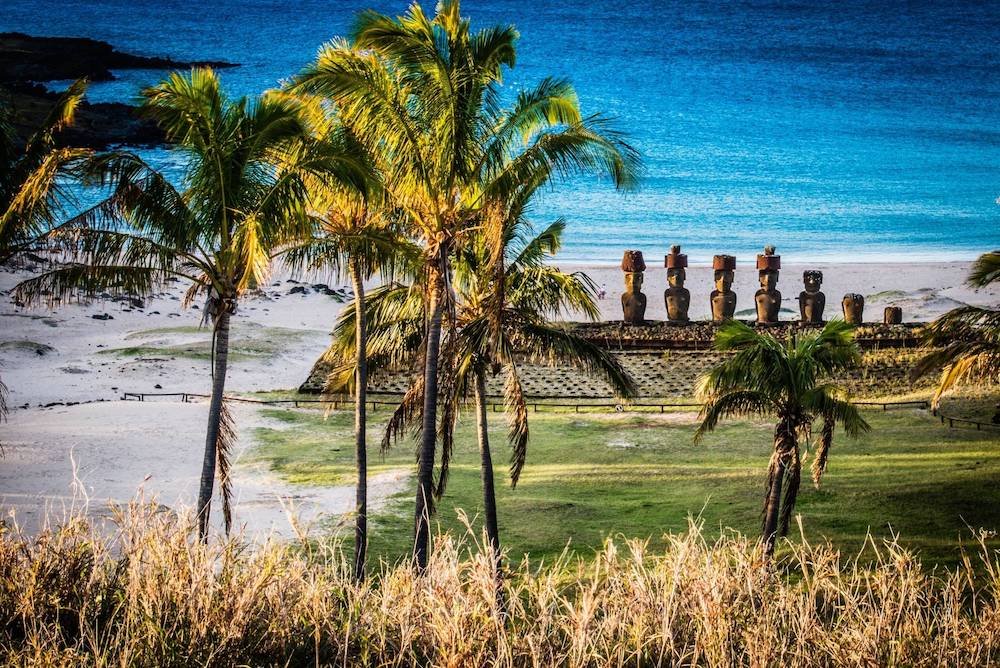
FAQ’s About Easter Island:
How do people travel to Easter Island?
People travel to Easter Island primarily by air, landing at Mataveri International Airport, which is the island’s sole airport.
The majority of flights come from Santiago, Chile, with LATAM Airlines being the main carrier offering regular service to the island.
Given Easter Island’s remote location in the Pacific Ocean, flying is the only feasible option for tourists looking to visit.
How much does it cost to go to Easter Island?
The cost of a trip to Easter Island can vary significantly based on factors like the point of departure, time of booking, length of stay, and personal spending habits.
A major cost component is the flight, which can range from $800 to $1,200 for a round-trip ticket from Santiago, Chile.
Accommodation costs can vary, with options ranging from $50 per night for guesthouses to over $250 per night for luxury hotels.
Daily expenses for meals, transportation, and activities on the island can add up to about $100 to $200 per day.
Therefore, a week-long trip could cost anywhere from $2,000 to $4,000 per person, depending on the level of comfort and activities planned.
Is Easter Island worth it?
Yes, Easter Island is considered worth visiting by many travelers due to its unique archaeological sites, including the famous Moai statues, its rich Polynesian culture, and its stunning natural landscapes.
Despite its remote location and the costs involved, the experience of exploring this isolated island, with its fascinating history and culture, is often described as unparalleled and unforgettable.
Why is it so expensive to go to Easter Island?
The high cost of traveling to Easter Island is largely due to its remote location, which requires significant logistical planning and resources to reach.
Limited transportation options, with only a few flights available, contribute to higher airfare prices.
Additionally, because all goods and supplies must be imported to the island, the cost of accommodations, food, and services tends to be higher than in more easily accessible destinations.
How many days is enough in Easter Island?
A minimum of three to five days is recommended to explore the key archaeological sites, cultural attractions, and natural beauty of Easter Island.
This allows for ample time to visit the major Moai sites, such as Ahu Tongariki and Rano Raraku, enjoy the beaches, and participate in a few cultural or outdoor activities.
Those with a deeper interest in archaeology or who wish to explore the island more thoroughly might opt for a longer stay of up to a week.
What is the best month to visit Easter Island?
The best months to visit Easter Island are during the shoulder seasons of March to June and September to November.
These periods offer pleasant weather, fewer crowds, and the opportunity to experience the island’s natural and cultural sites more comfortably.
February is also a popular time due to the Tapati Rapa Nui Festival, although it’s busier and accommodations can be scarce.
Can you stay overnight at Easter Island?
Yes, you can stay overnight at Easter Island.
The island offers a variety of accommodation options, including hotels, guesthouses, and camping facilities, catering to different budgets and preferences.
Booking in advance is highly recommended, especially during peak travel seasons and around the time of the Tapati Festival.
Does Easter Island have Internet?
Yes, Easter Island has internet access.
While it may not be as fast or reliable as in more urbanized areas due to the island’s remote location, most hotels, guesthouses, and some cafes and restaurants offer Wi-Fi to their customers.
Visitors should be prepared for potentially slower connections and limited coverage in more remote areas of the island.
